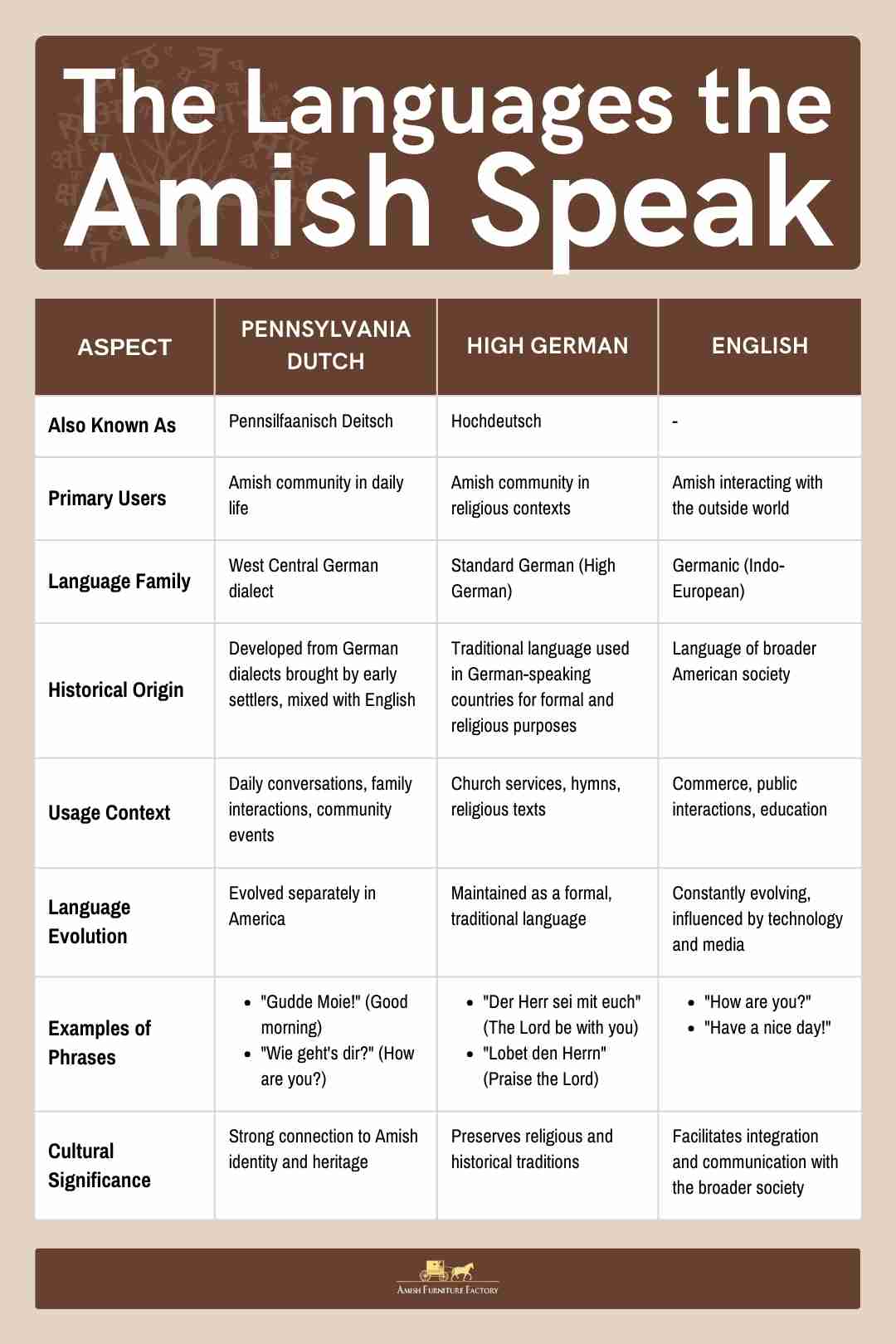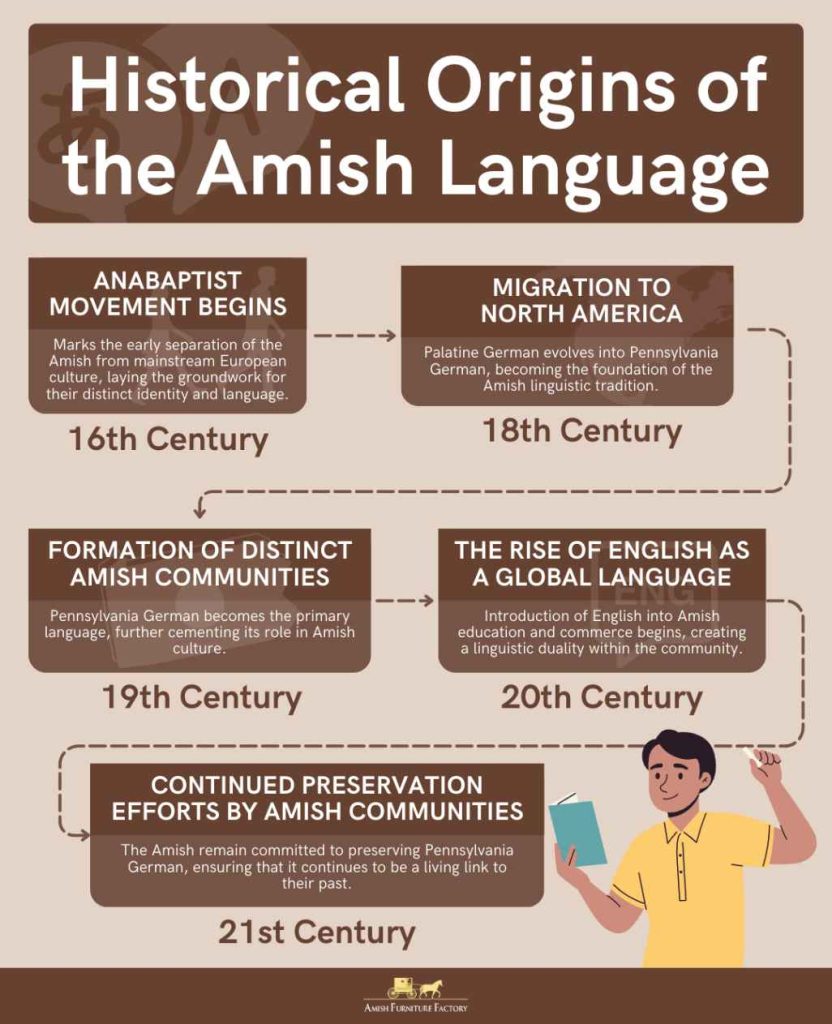What language echoes through the quiet lanes and bustling farms of Amish communities? The Amish primarily speak Pennsylvania Dutch, a unique dialect with roots in 18th-century European migration, offering a fascinating window into their culture and traditions.
Delving into the linguistic landscape of the Amish offers a compelling look at their heritage. Its a story of cultural preservation, linguistic adaptation, and a deep connection to the past. The answer to the question of what language the Amish speak isn't as straightforward as one might initially assume. While Pennsylvania Dutch, also known as Pennsylvania German, is the most widely spoken, it's only one piece of the puzzle. English plays a crucial role, bridging the gap with the outside world, and High German, the language of church, holds a significant place in their religious lives. The Amish, known for their simple living and strong community ties, have preserved a language and a way of life that is distinct from the modern world.
Pennsylvania Dutch isn't merely a language; it's a living testament to the Amish's historical roots. The dialect is a fascinating blend, primarily of German with significant influences from Dutch and English. This linguistic amalgamation is a direct result of the migration patterns of the 18th century, when German-speaking communities, including Swiss and Alsatian groups, settled in Pennsylvania. These early settlers brought with them their regional dialects, which, over time, evolved and coalesced into what we now recognize as Pennsylvania Dutch. The language is more than just words and grammar; it's the embodiment of a culture's values and its unbroken connection to its origins. The preservation of Pennsylvania Dutch speaks volumes about the Amish commitment to maintaining their unique identity.
The use of English is essential for interaction beyond the community. It is the language used in schools, in business interactions with outsiders, and in some cases, in public spaces. This bilingualism allows the Amish to navigate the modern world while maintaining their cultural distinctiveness. High German, on the other hand, serves a spiritual purpose, used in church services and religious texts. It is a language that carries with it the weight of tradition and spiritual identity.
The Amish communities are not monolithic; variations exist. Some communities, notably in Indiana, speak Alemannic dialects, a further reflection of the diverse origins within the broader Amish population. Understanding these variations highlights the dynamism and adaptability of the Amish language, demonstrating its ability to reflect the specific histories and experiences of different groups.
Here is a table with basic information to have a better idea of the Amish people's life, including the language they speak. This will help the user have more information on the topic, this data can be easily inserted into WordPress.
| Feature | Details |
|---|---|
| Primary Language | Pennsylvania Dutch (a dialect of German with influences from Dutch and English) |
| Secondary Languages | English, High German (used for church) |
| Origin | German-speaking immigrants (Swiss, Alsatian, and German) who settled in Pennsylvania in the 18th century |
| Geographic Distribution | Primarily in Pennsylvania, Ohio, Indiana, and other parts of North America. (Lancaster County, PA is a major center) |
| Cultural Practices | Simple living, plain dress, separation from the modern world, strong community ties, reliance on family and faith |
| Education | Typically, education up to the eighth grade. Emphasis on practical skills and religious instruction. |
| Community Structure | Close-knit, family-centered, with strong emphasis on community support and mutual aid. |
| Economic Activities | Agriculture, crafts, and small businesses. Avoidance of modern technologies that conflict with their way of life. |
| Religious Affiliation | Anabaptist Christian faith, with emphasis on adult baptism and separation from the world. |
| Dialectal Variations | Alemannic dialects spoken by some Amish communities in Indiana. |
| Language Preservation | Pennsylvania Dutch is primarily used within the community, and transmitted to children as their first language. |
| Use of English | Essential for communication with the outside world, business, and education. |
| Use of High German | Primarily for religious purposes and church services. |
| Interaction with Outsiders | Limited interaction, although growing tourism and economic activities necessitate some degree of contact. |
| Traditions | Strong emphasis on preserving their culture, avoiding modern technologies, and maintaining their religious beliefs. |
| Sources | Wikipedia - Amish |
The origins of Pennsylvania Dutch can be traced back to the migration of around 81,000 German speakers to Pennsylvania during the 18th century. These individuals hailed from various regions of central and southwestern Germany, Alsace, and Switzerland. At that time, regional dialects varied considerably, evolving over time into the dialect that is known today. The Amish language, therefore, is a testament to the Swiss German and Alsatian roots of this group, and it is a vibrant link to their history and culture.
Pennsylvania Dutch serves as a vital cultural marker for the Amish, a cornerstone of their communal identity. The dialect is used primarily within the community, and the majority of Amish children learn it as their first language. This emphasis on Pennsylvania Dutch reinforces the strong family and community ties, creating a shared linguistic experience that sets the Amish apart. This separation extends into all areas of life, where maintaining their unique heritage is their main priority.
English and High German are also significant in their lives. English facilitates communication with the outside world, while High German is used within their religious practices. The Amish learn to read, write, and speak English, enabling them to interact with the wider community. This bilingualism allows them to engage in the marketplace and also engage in business. High German provides the spiritual dimension for the Amish people, giving the language an important part in their community.
In Lancaster County, Pennsylvania, Pennsylvania Dutch remains the most commonly used language among the Amish communities. It is the language of daily conversation, family interactions, and community gatherings. Learning a few Pennsylvania Dutch words and phrases can offer deeper insights into their culture and traditions. It is said that even though they are separate from the modern world, some communities have welcomed tourists to their areas, which has helped them earn money to take care of their families and communities.
The Amish communitys practice of simple living, plain dress, and their reluctance to adopt many conveniences of modern technology extend to the language they speak. This shows how much importance they put on preserving their culture. Pennsylvania Dutch, with its distinct characteristics, serves as a symbol of this separation, helping to retain the cultural differences that make the Amish unique. The Amish have an amazing community, and the fact that they've remained relatively untouched by outside influences is the reason people are so fascinated by them. The language they speak, Pennsylvania Dutch, is very important to them.
It is interesting to consider how the Amish language, Pennsylvania Dutch, is a living legacy of cultural preservation, linguistic evolution, and the enduring strength of community. It provides a fascinating insight into the Amish world. The Amish language is much more than just words; it's a way of life.


